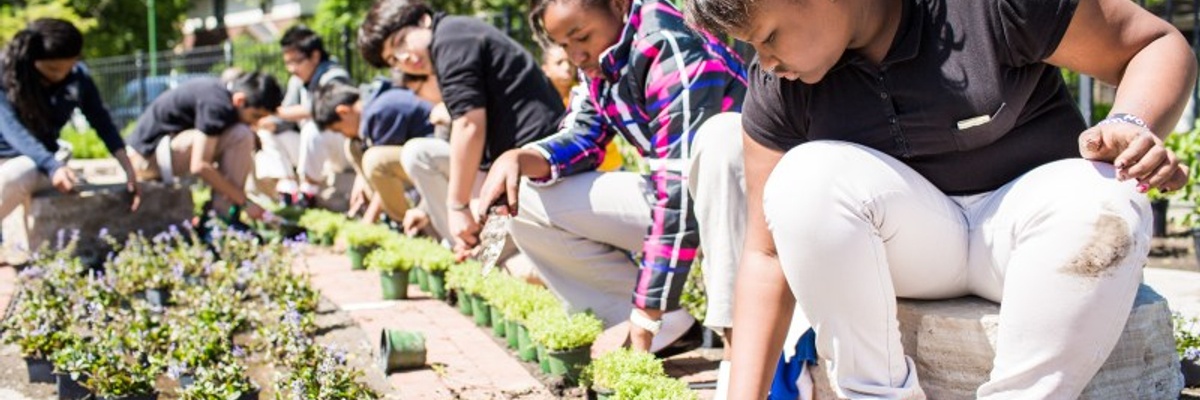Get Chicago Public Schools approval
The very first step is to make sure that your school already has been granted permission in the past by Chicago Public Schools to build or add to a garden. Work with your principal to get approval from facilities whenever you are making changes to your school’s landscape. Many schools are not making good use of their school gardens or the gardens may have have fallen into disrepair and be completely decommissioned. If this sounds familiar then follow these 5 steps, and the full Building School Gardens manual to bring your garden back to life and provide a guided, safe way for your school community to connect with the outdoors and all of its benefits.
Community engagement
It’s important to engage the school community with the garden. It has the potential to bring joy to hundreds, maybe thousands, of people everyday! Be sure to not just engage people with the garden when it’s time to work, but try to have fun events in the garden as well, such as tea parties, scavenger hunts, yoga and meditation, or potlucks! Share with your community the awesome things that are happening with the garden through pictures and stories. Keeping a school garden thriving can be a challenge, but a large and strong garden team will keep it going through changes that the school goes through. Not everyone has to have a green thumb, so maybe some people’s strengths are hosting events, community outreach, curriculum development, or writing blurbs for the newsletter.
- Staff support. A school garden must be created and maintained by more than just one teacher’s efforts. An initially involved teacher, for one reason or another, may leave the school. It is better to have a group to begin with than a lone, outgoing staff member trying to recruit a colleague to take over the garden.
- School administration support. Actual administrator support, not just acceptance of the school garden, can ensure that it becomes an integral part of the curriculum, as well as just be watered by maintenance staff over the summer.
- Community/parent involvement. This aids in taking the summer maintenance and organizational weight off school staff and provides more support for the garden. This support is priceless!
Plan – Design garden and set a budget
Involving the students in the creation, installation, and stewardship of the school garden is a major component of the Building School Gardens Program. We believe giving students the opportunity to voice their ideas and opinions and participate in the creation of the garden not only gives them ownership of the garden but also strengthens their commitment to their education and the community as a whole.
During the planning process, we encourage schools to gather input from the students. Ideas about where the garden could go, what the garden can look like, or features they would like to see should be gathered and shared when discussing the garden design. Once the type of garden(s) - edible, ornamental, native, or a combination - has been determined, the students can choose the plants that will be grown in the garden. Other ideas include: researching the plants that will be in the garden, creating a plant ID book specifically for your school garden, or making seed tape that can be used on planting day.
Incorporating an art component into the school garden is another way to increase the students’ participation in the school garden. Students can create stepping stones, plant signs, garden signs, or other simple structures that can be displayed in the garden. Building a trellis can be a great art project and can also be used as a functional piece. Continually “planting” new art pieces is a great way to continue the momentum and excitement in the garden.
After you decide what type of garden you will rebuild, create a budget for materials such as tools, soil, seeds, mulch, plants, etc.
Plant!
Organize different classes who can adopt different sections of the garden to plant. When you plant with students explain to them the importance of the garden that they are planting, whether you’re growing healthy food or providing habitat for important pollinators, but they are also being leaders by beautifying their school. It’s great to have multiple adults outside at once during garden time. For outdoor classroom management, work with the students to develop rules for how they will behave in the garden. The more that you go into the garden with students, the more they’ll be used to how to behave!
If possible, plan a day that parents and community members can be a part of building the garden. If possible, work to find out what time and day works best for parents. If people have a hand in planting the garden, they’re more likely to take care of it later.
Develop and implement your maintenance schedule
Adding a school garden leads to additional maintenance - what we like to call stewardship - in order to sustain the garden. Many questions need to be answered: Who will be responsible for the watering of the garden? Who will weed the garden? Who will harvest the fruits from the garden? Openlands encourages each school to create a stewardship plan that includes the stewardship activities and the steward(s) that are responsible for each activity. See pages 12-16 of the Building School Gardens manual to see sample Stewardship plans from other schools and detailed plans for tasks such as watering and harvesting.
Your school’s Garden Tracker should be a “go to” manual that houses everything there is to know about your garden. It may be beneficial to have one working copy and an extra copy just in case the working copy gets lost, misplaced, or damaged. As material is added to the working copy a copy should be made for the extra copy as well. The Garden Tracker should be kept in an area that will be accessible to all of those who participate in the garden as well as for those who would like to learn about the garden. Check out page 7 of the Building School Gardens manual for more ideas about what to include in the tracker, such as photos, plants lists, supplier lists and planting dates.
This calendar will guide you so you know which stewardship activities should be happening from month to month.
Fill out these worksheets with your team to identify what your garden needs, how you can identify roles for these needs, and who can fill those roles.
Review this Building your Garden Team sheet for ideas of who to recruit for your team and some ideas for roles that they can fill.









 "Welcome to Building School Gardens on ChangeX! Here you'll find the information you need to re-do your decommissioned school garden. Each of us can have a positive impact in our schools and communities by providing a guided, safe way to connect with the outdoors and all of its benefits. Thanks for joining, we're excited to have you with us!"
- Danielle Russell, Openlands
"Welcome to Building School Gardens on ChangeX! Here you'll find the information you need to re-do your decommissioned school garden. Each of us can have a positive impact in our schools and communities by providing a guided, safe way to connect with the outdoors and all of its benefits. Thanks for joining, we're excited to have you with us!"
- Danielle Russell, Openlands
